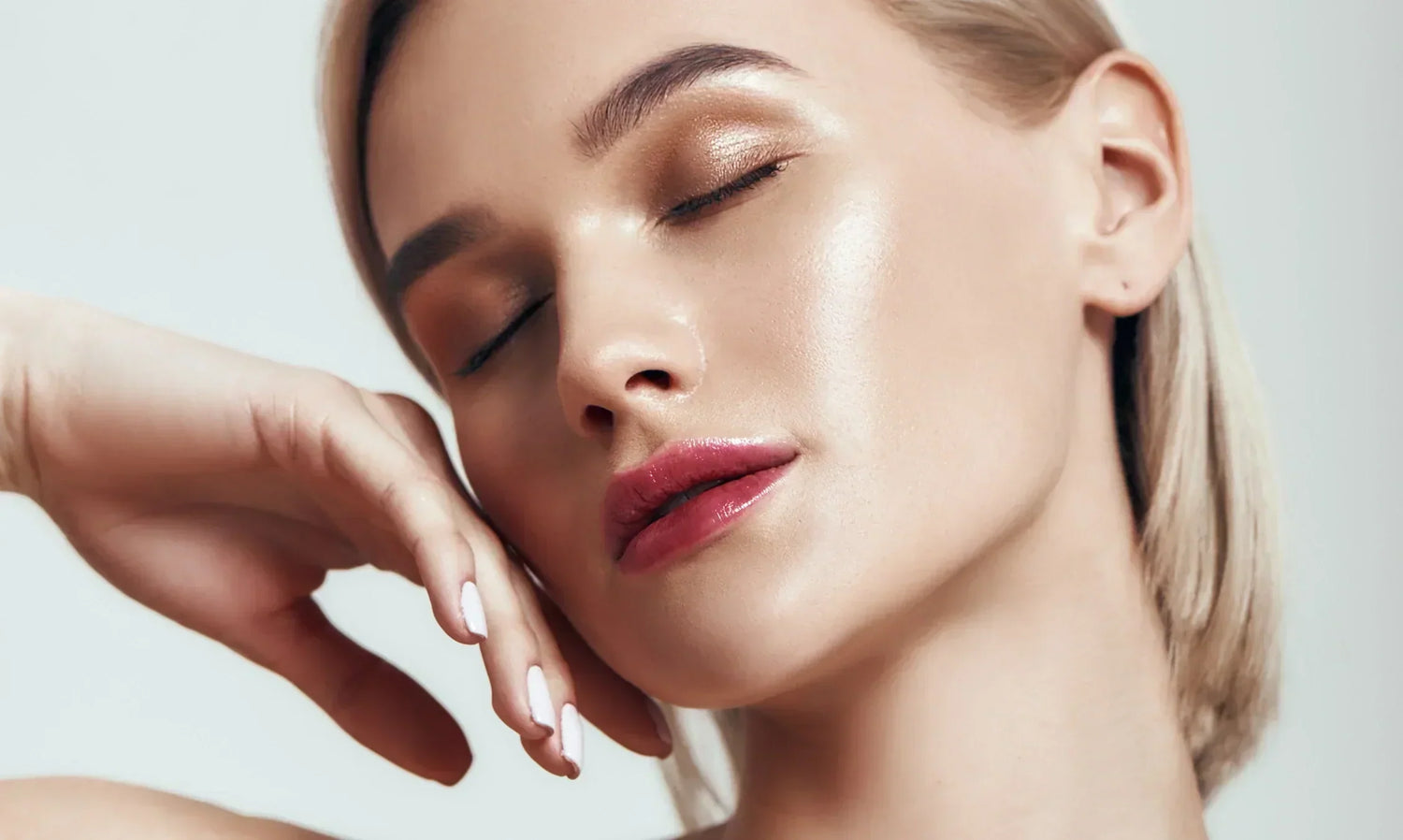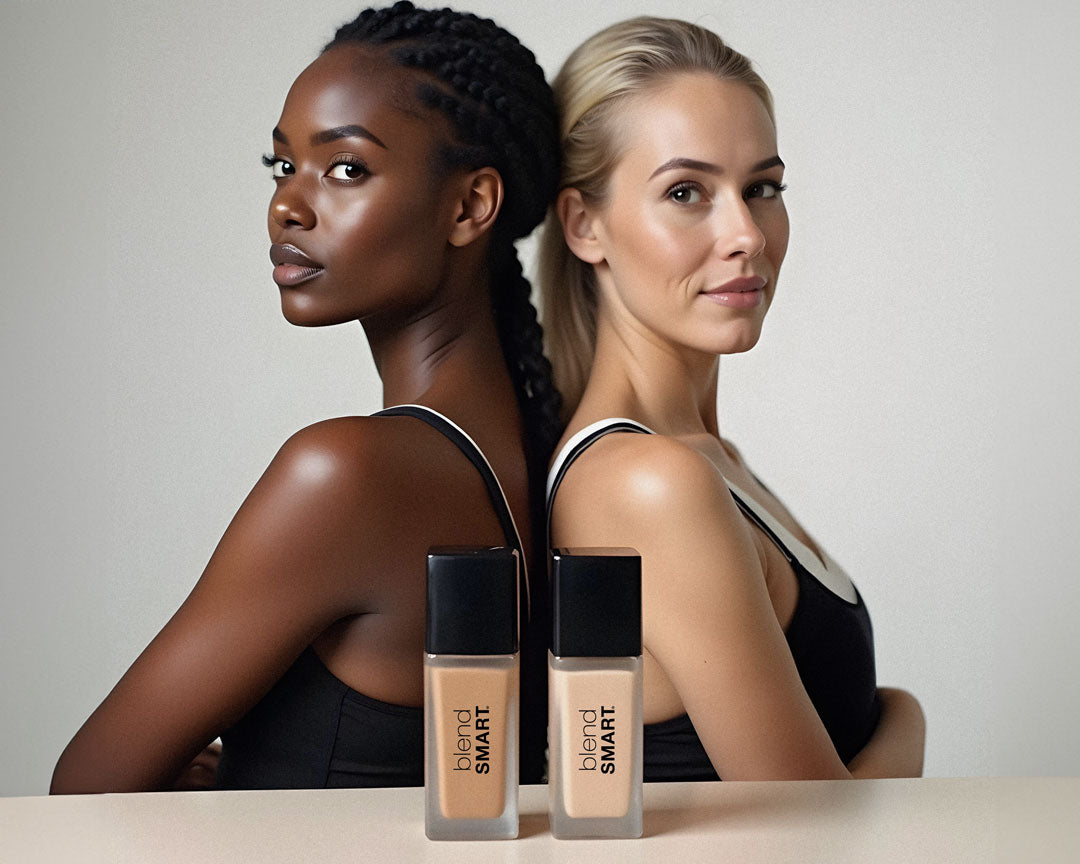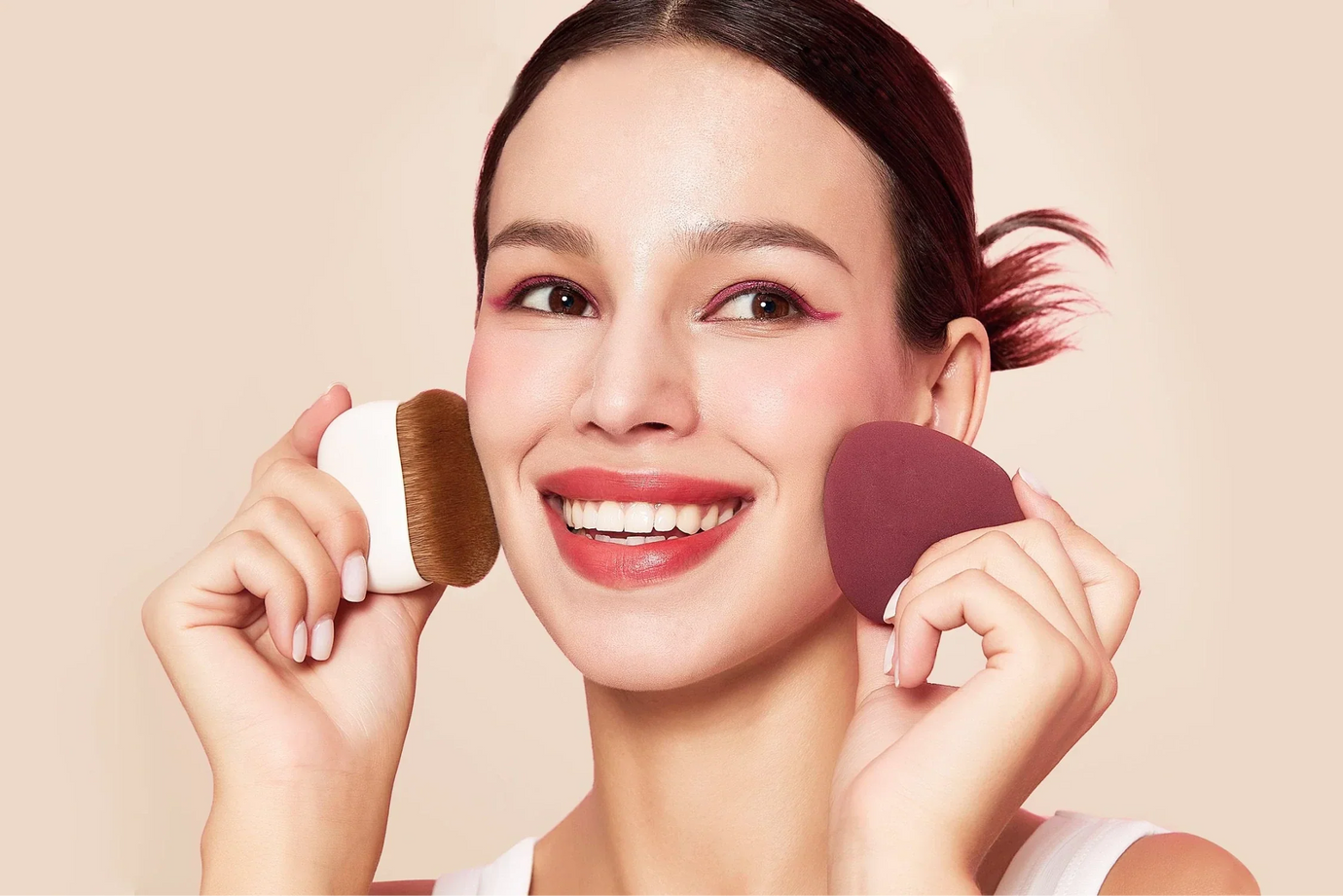How to Prep Your Skin for Flawless Makeup [Pro Tips for Every Skin Type]

You’ve got the perfect foundation, the right lighting, and your makeup brushes lined up like little soldiers. But five minutes in, your base is already patchy, your T-zone is shining like a disco ball, and somehow, your concealer is clinging to flakes you didn’t even know existed. Sound familiar?
Here’s the truth: if your makeup isn’t sitting right, the problem probably isn’t your products—it’s your skin prep.
Knowing how to prep your skin for makeup is the difference between a flawless, second-skin finish and a full face that melts, cracks, or disappears before lunch. And the best part? It doesn’t take a million steps or a 15-step skincare routine. With the right prep tailored to your skin type, your foundation goes on smoother, lasts longer, and looks way more natural.
In this guide, we’re breaking down the best skin prep for makeup for every skin type—dry, oily, combination, sensitive—and even what to do when you’re rushing out the door with zero prep time. Grab your moisturizer (and maybe your favorite sonic brush), and let’s get into it.
Table of Contents
- Why Skin Prep Matters More Than You Think
- 6 Core Skin Prep Steps Everyone Should Follow
- How to Customize Your Skin Prep for Your Skin Type
- Intensive Skin Prep for Long-Lasting Event Makeup
- What to Do If You Didn’t Prep Properly
Why Skin Prep Matters More Than You Think
Think of skin prep as the behind-the-scenes crew for a flawless makeup look. You don’t always notice it—but without it, the show falls apart.
Proper skin prep helps your makeup glide on, blend seamlessly, and stay put. It keeps your base from clinging to dry spots, sliding off oily zones, or caking into fine lines. Even better? It minimizes the amount of product you need—because when your skin is hydrated and balanced, everything else just works.
It’s not about using more skincare. It’s about using the right steps, in the right order, for your unique skin. And that’s exactly what we’re diving into next.
The 6 Core Skin Prep Steps Everyone Should Follow
Skin prep doesn’t need to be complicated—but skipping it? That’s the fastest way to ruin an otherwise flawless makeup look. Whether you’re going full glam or keeping it light, these six core steps build the perfect base for smooth application, better blendability, and long-lasting wear.
1. Cleanse (Just a Splash Will Do)
If you’re already cleansing thoroughly at night (removing sunscreen, makeup, and buildup), there’s usually no need to do a full cleanse again in the morning. In fact, over-cleansing can actually disrupt your skin barrier—stripping away natural oils and microbiome balance that help keep your skin healthy, hydrated, and calm.

That’s why a simple splash of lukewarm water is often more than enough. It gently rinses away any light oil, sweat, or pillow residue from overnight without stressing the skin. This minimalist approach helps maintain your skin’s natural moisture and keeps your barrier intact—especially important if you're layering on makeup right after.
2. Tone or Mist
Once your skin is refreshed, a toner or facial mist helps bring everything back into balance—literally. Toners are designed to rebalance your skin’s pH, especially after cleansing, and to lightly rehydrate so your skin can better absorb what comes next.

Think of it as your skin’s “reset” step: it calms, softens, and primes your face for serums and moisturizers. Bonus? It also helps remove any lingering residue from your rinse (or from your pillowcase—hey, it happens).
Mists offer similar hydration benefits in a quicker format, and they’re great for waking up tired morning skin. Just spritz and go.
You can pour toner into your hands and press it in, or spray and pat with a mist. Either way, it’s a small step that makes a noticeable difference.
3. Hydrate with a Serum
This is where the magic starts to happen. A good hydrating serum gives your skin that plump, dewy look that makes foundation go on like silk. It fills in fine lines, smooths dry texture, and helps prevent your base from looking cakey or uneven.

What makes a serum different from a moisturizer? Serums are lighter and more concentrated, so they absorb deeper and deliver hydration into the skin, not just on top of it.
Look for hydrating ingredients like:
- Hyaluronic acid – a hydration magnet that draws water into the skin
- Glycerin – helps retain moisture and improve skin elasticity
- Panthenol – soothes and strengthens the skin barrier
- Polyglutamic acid – holds even more moisture than hyaluronic acid (yes, really)
Apply 2–3 drops to damp skin and gently press it in. Or, for an even more even (and hands-free) application, use the blendSMART Skincare Kit. The rotating skincare brush massages the serum evenly across your face and helps it absorb deeper—plus, it feels ridiculously good.
This step may be quick, but it’s what gives your makeup that smooth, hydrated glow instead of a tight, dry finish.
4. Moisturize
Moisturizer is the backbone of your skin prep routine. After applying a hydrating serum, this step seals everything in and creates a smooth, cushioned surface for your makeup to glide over.

Skipping it can lead to all kinds of issues—like foundation clinging to dry areas, separating around your nose or mouth, or emphasizing fine lines. And even if your skin feels okay, moisturizer helps maintain hydration throughout the day—especially under makeup that can be drying over time.
Apply a thin, even layer and let it absorb fully before moving on. That quick pause gives your base a better grip and helps prevent pilling.
Here too, you can use the rotating skincare brush to gently buff the moisturizer into your skin. It helps with even distribution and adds a relaxing, spa-like feel to your routine—because a little luxury never hurts.
5. Sunscreen (If It’s Daytime, It’s a Must)
Makeup can do a lot of things—but it can’t protect your skin from UV damage. If you’re heading outside (even just for errands or a coffee run), sunscreen should always be part of your prep. It helps prevent sunspots, premature aging, and texture issues that even the best foundation can’t fully hide.

Use a broad-spectrum SPF 30 or higher, and look for a formula that layers well under makeup—something lightweight, non-greasy, and with zero white cast or pilling.
Let it sink in completely before moving on to the primer. You’ll get better protection and a smoother canvas all around.
6. Prime (Optional—but Effective)
Primer isn’t a requirement—but it can be a total game-changer. Think of it as your makeup’s insurance policy: it helps foundation go on smoother, last longer, and stay in place through heat, humidity, or long days at work.

Depending on the formula, primer can also subtly blur pores, soften texture, reduce shine, or add a dewy finish. You don’t need to cover your entire face—just apply a small amount where you need the extra support, like the T-zone, around the nose, or under the eyes.
Let it set for a few seconds before applying your foundation. That way, you’re building on a smooth, grippy base—not a slippery one.
If you’re doing your makeup for a big event or a long day, this step becomes even more valuable. But even for everyday wear, a good primer can help your base look a little more polished—with barely any extra effort.
How to Customize Your Skin Prep for Your Skin Type
Now that we’ve covered the foundation of a solid skin prep routine, let’s take it a step further. Because while the core steps apply to everyone, your skin type plays a big role in how each step should be done.
We’ll walk through how to adjust the routine for dry, oily, combination, and sensitive skin—so you can prep in a way that actually works for your face.
How to Prep Dry Skin for Makeup
Common Challenges
Dry skin can be sneaky. It might feel tight, look dull, or have those tiny flaky patches that foundation loves to cling to. Even lightweight makeup can end up looking cakey or textured if your skin isn’t properly prepped. And once it sets? Forget about re-blending—it’s already locked onto the flakes.
Fine-Tune Your Routine for Dry Skin
The core skin prep steps still apply—but if your skin leans dry, these simple tweaks will help you build a smoother, more hydrated base that makeup actually wants to stick to.
-
Choose a deeply hydrating toner or essence. Look for formulas with humectants like panthenol, aloe, or fermented ingredients. These add moisture from the very first layer.
-
Layer a face oil after moisturizer (optional). A few drops of rosehip, marula, or squalane can help seal in hydration and prevent tightness—especially in cold weather or dry climates.
-
Use a rich, barrier-repair moisturizer. Ingredients like ceramides, shea butter, or colloidal oatmeal nourish and support long-lasting hydration.
-
Opt for a creamy sunscreen. Lightweight SPFs can sometimes emphasize dry texture. A moisturizing, non-matte sunscreen doubles as an extra hydrating layer and sits more comfortably under foundation.
-
Pick a hydrating or illuminating primer. Steer clear of anything mattifying. Instead, look for primers with ingredients like glycerin or vitamin E that offer a dewy finish and help foundation blend more easily over dry areas.
How to Prep Oily Skin for Makeup
Common Challenges
With oily skin, the first few hours of makeup might look flawless—but by lunch, your T-zone is shining, your foundation is breaking apart, and your mascara might be flirting with your under-eyes.
Excess sebum can cause makeup to slide, separate, or oxidize (turn orange-ish), and it often exaggerates texture or large pores. The key to prepping oily skin isn’t stripping it dry—it’s finding balance. When your skin feels hydrated and supported, it produces less oil, not more.
Fine-Tune Your Routine for Oily Skin
If you’re working with excess oil or midday shine, stick to the core steps—but make these targeted changes to help control sebum and keep your makeup in place longer.
-
Use a balancing toner. Look for ingredients like niacinamide, witch hazel, or green tea extract. These help reduce shine, tighten pores, and calm down inflammation without drying you out.
-
Lightweight serum is key. Stick to oil-free hydrating serums with ingredients like hyaluronic acid or zinc PCA. Avoid layering too many actives before makeup.
-
Go for a gel-based moisturizer. You still need moisture—just in a lighter, non-comedogenic format that hydrates without leaving residue.
-
Choose a fluid or matte-finish sunscreen. Opt for one that controls oil and layers well under makeup. Some even double as a primer.
-
Use a mattifying or pore-blurring primer. Focus it on areas that tend to get shiny—usually the T-zone. The blendSMART Camera Ready Foundation Primer is a solid option for controlling oil without feeling dry or heavy, helping makeup last longer and keeping midday shine in check.
How to Prep Combination Skin for Makeup
Common Challenges
Combination skin keeps you guessing—dry patches here, oily shine there, and maybe a breakout just to keep things interesting. The biggest struggle? Prepping in a way that doesn’t over-moisturize one area while under-hydrating another.
The goal is targeted balance: treating each zone of your face based on what it needs, so your makeup looks even and wears well from cheek to chin.
Fine-Tune Your Routine for Combination Skin
You don’t need an entirely separate routine—just a few smart tweaks. These adjustments help balance the dry and oily zones so your base wears evenly throughout the day.
-
Use a multi-tasking toner. Look for soothing, non-drying formulas with ingredients like niacinamide, rose water, or centella asiatica. They help balance oil and calm dry patches at the same time.
-
Spot-treat with serums if needed. Apply lightweight hydrating serum all over, but feel free to add a few drops of mattifying or pore-refining serum just to your T-zone.
-
Try layered moisturizers. Use a gel moisturizer where you get oily and a richer cream on drier areas like your cheeks. Or mix the two in your hand before applying.
-
Pick a sunscreen that plays nice. A satin or natural-finish SPF works well here—not too dewy, not too matte.
-
Customize your primer placement. Apply a mattifying primer to your T-zone and a hydrating or glow-enhancing primer elsewhere. You don’t have to pick just one.
How to Prep Sensitive Skin for Makeup
Common Challenges
Sensitive skin is unpredictable—it can look fine one day and flare up the next. Redness, stinging, dry patches, and irritation often show up uninvited, especially when you're layering multiple products or applying makeup too aggressively.
The goal with sensitive skin prep is to keep things simple. You want to soothe, protect, and minimize friction—so your skin feels calm and your makeup doesn’t cause or highlight irritation.
Fine-Tune Your Routine for Sensitive Skin
Sensitive skin doesn’t need a totally different routine—it just needs a gentler touch. Here’s how to modify the basics to calm irritation and prep without overwhelming your skin.
-
Stick to minimal-ingredient toners or mists. Go for calming ingredients like chamomile, centella asiatica (cica), thermal spring water, or aloe. Avoid fragrance or alcohol.
-
Use a serum with barrier-supporting benefits. Niacinamide, beta-glucan, and ceramides are great choices for calming and strengthening the skin over time.
-
Moisturize with something soothing and non-reactive. Choose barrier creams or balms with ingredients like colloidal oatmeal or squalane. Look for formulas labeled hypoallergenic or designed for reactive skin.
-
Pick a mineral sunscreen. Chemical filters can trigger sensitivity, so go for a zinc oxide or titanium dioxide-based SPF. Choose one that’s designed to layer well under makeup.
-
Choose a gentle primer—or skip it. If your skin tolerates it, a green-tinted primer can help neutralize redness. Otherwise, skip it and let your skincare act as your base.
Intensive Skin Prep for Long-Lasting Event Makeup
When you need your makeup to stay flawless from morning to midnight, a little extra prep goes a long way.
The night before, gently exfoliate (if your skin tolerates it) and follow up with a hydrating mask or sleeping pack to plump and smooth your skin. Stick to products your skin already loves—no surprises before a big day.
On the day of, start early and layer slowly. Give each product time to absorb to prevent pilling. Use a chilled roller or the blendSMART Skincare Kit for a light facial massage to reduce puffiness and boost glow. Opt for a long-wear foundation and finish with a gripping primer and setting spray to lock everything in.

Don’t forget to blot before foundation and press, don’t rub. With the right prep, your makeup will look fresh, feel comfortable, and stay in place—no matter how long the event runs.
Quick Fixes: What to Do If You Didn’t Prep Properly
We’ve all been there—you're halfway through applying foundation when you realize your skin feels off. Maybe you skipped moisturizer, or your primer is... somewhere. Don’t panic. Here’s how to course-correct:
-
Flaky or dry patches? Tap a bit of moisturizer on top of makeup using your fingers or a clean brush. Let it sit, then gently press with a sponge.
-
Looking oily? Blot with tissue or blotting paper, then dust with a light layer of translucent powder.
-
Base looks cakey? Mist your face lightly, then press everything in with a damp sponge or your brush to smooth it out.
-
No primer? Use a setting spray before foundation for a grip-like effect.
Even the best routines go sideways sometimes—but with a few quick tricks, your makeup can still turn out great.
Conclusion
Perfect makeup doesn’t just come from the right foundation or the latest trending blush—it starts with how you prep your skin. Whether you're dealing with dryness, shine, sensitivity, or all of the above, a few targeted steps can completely change how your makeup looks and feels.
The good news? Skin prep doesn’t have to be complicated. Once you understand your skin’s needs and make a few smart swaps—like using hydrating serums, lightweight moisturizers, or a primer that actually works with your skin—you’ll start seeing real results. Smoother blending. Longer wear. Fewer midday meltdowns.
Flawless makeup is all about treating your skin well before the makeup brush ever hits your face.


![Best Foundations for Dry Skin [10 Top Picks + Pro Tips]](http://blendsmart.co.uk/cdn/shop/articles/Untitled_design_2.jpg?v=1754050507&width=1380)

